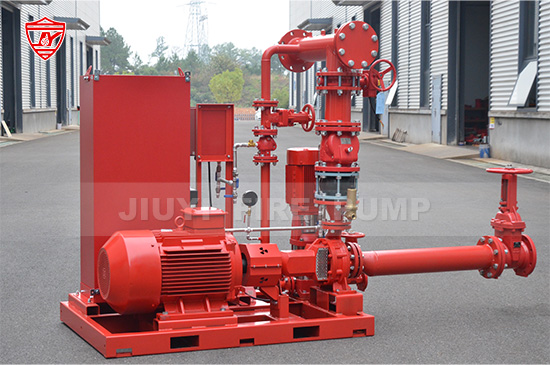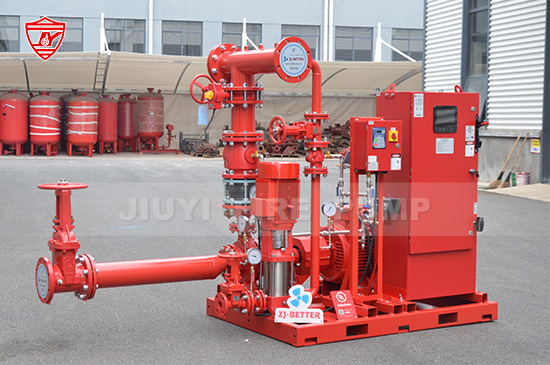A UL Listed fire pump is one of the most critical components of a building’s fire protection system. It is engineered to perform under extreme conditions, delivering reliable water flow and pressure when an emergency occurs. However, even the best UL fire pump cannot remain reliable without a structured and well-executed maintenance schedule.
This article provides a complete guide to UL fire pump maintenance scheduling, including inspection timelines, test procedures, compliance requirements, and common mistakes to avoid. Whether you are a fire protection engineer, facility manager, or contractor, this resource will help you ensure long-term performance and compliance.

UL certification ensures that a fire pump meets strict performance and safety standards, but real-world reliability comes down to consistent maintenance. A structured schedule helps:
Ensure the pump will operate instantly in case of fire
Reduce failure risks caused by mechanical wear, corrosion, or electrical issues
Maintain NFPA 20 and NFPA 25 compliance
Extend the service life of the pump and its components
Avoid costly emergency repairs and downtime
Provide traceable documentation for insurance and regulatory audits
Skipping or delaying maintenance is one of the most common causes of fire pump failure during emergencies.
A proper maintenance schedule includes regular inspections, functional tests, data recording, and periodic major servicing. UL fire pump maintenance follows NFPA 25—the standard for inspection, testing, and maintenance of water-based fire protection systems.
Maintenance scheduling is typically divided into several categories:
Weekly: Routine visual checks and no-flow tests
Monthly: Detailed inspection and performance review
Quarterly: Component-level checks and lubrication
Semi-Annual: System evaluation and electrical system tests
Annual: Full operational tests and performance verification
Long-term cycle: Major components replacement and system overhaul
Understanding each interval is essential for proper compliance and pump performance.
Weekly inspections form the backbone of a reliable UL fire pump maintenance program. They help detect early issues before they escalate.
Check for:
Any leakage at pump, casing, glands, or valves
Abnormal noise or vibration
Alignment of pump and driver
Pressure gauge readings
Controller conditions and indicator status
Battery voltage (for diesel engines)
Water supply availability
Weekly inspections should be quick but thorough.
This is one of the most important weekly tasks.
The no-flow test ensures:
Pump starts automatically
Pump reaches required rated pressure
Controller responds correctly
Diesel engine operates smoothly (for diesel sets)
Typically run for 10–30 minutes, depending on local requirements.
Monthly tasks involve deeper evaluation compared to weekly inspections.
Check the valve’s operation and look for blockages or corrosion.
Diesel UL fire pumps require strong attention to:
Fuel tank condition
Fuel water drainage
Lubricating oil quality
Coolant levels
Ensure:
All indicator lights function
Alarms are active and responsive
Manual start and stop features work safely
The jockey pump helps maintain system pressure. Proper monthly maintenance ensures:
Stable start and stop pressures
No short-cycling
Correct system pressure balance
Quarterly tasks involve more detailed inspection and adjustments.
Misalignment can lead to severe vibration, seal damage, and bearing wear.
Lubricants must match manufacturer recommendations to avoid overheating.
All valves should be turned fully open and closed to prevent seizing.
Ensure that the water supply path is clear and unobstructed.
These tasks are slightly less frequent but essential for UL fire pump reliability.
Inspect:
Internal wiring
Contacts
Connections
Protective devices
Weak or failing battery chargers are a common cause of diesel pump failure.
Look for:
Carbon buildup
Leaks
Overheating signs
Annual maintenance is the most critical, involving full operational and performance evaluation.
This test verifies that the UL fire pump still meets:
Rated flow
Rated pressure
Shutoff pressure
Hydrant flow testing or test header flow is required depending on system layout.
Pump must be checked for:
Wear
Corrosion
Scaling
Blockage
This includes:
Voltage and current check
Load performance
Speed regulation
Cooling system evaluation
Fire pump controllers must be inspected for compliance and fully tested.
Long-term maintenance ensures that critical components remain reliable.
This usually includes:
Replacement of bearings
Seal replacement
Impeller balancing
Repainting or recoating
Tasks include:
Replacing injectors
Checking fuel pump timing
Cooling system overhaul
Older systems may require:
New circuit boards
Updated logic modules
Controller modernization
Below is a practical approach to building a maintenance schedule.
Every UL Listed fire pump comes with a maintenance guideline based on the specific model.
NFPA 25 is the industry standard for fire pump inspection, testing, and maintenance.
Consider:
Climate
Water quality
Frequency of pump operation
Diesel vs. electric configuration
Record:
Test results
Repairs
Replacement parts
Inspection dates
Good documentation is essential for compliance.
Avoiding these errors will boost reliability:
Treating maintenance as optional
Running tests without recording data
Ignoring abnormal vibration or noise
Skipping controller tests
Not flushing water supply lines
Using poor-quality lubricants
Overlooking diesel engine exhaust issues
Consistent, documented maintenance prevents long-term failures.
Use trends from vibration analysis, temperature readings, and performance curves.
Operators should understand:
Start-up procedures
Safety protocols
Troubleshooting basics
Non-certified parts reduce reliability and void compliance.
A certified service professional should perform annual and major maintenance.

A UL fire pump can only deliver maximum performance when supported by a comprehensive maintenance schedule. Weekly tests, monthly inspections, quarterly adjustments, and annual performance checks all work together to ensure compliance, reliability, and long-term safety.
By following industry standards and implementing a structured maintenance plan, facility owners and fire protection professionals can ensure that their fire pump systems perform flawlessly during emergencies. Proper maintenance is not just a requirement—it is the foundation of an effective fire protection strategy.